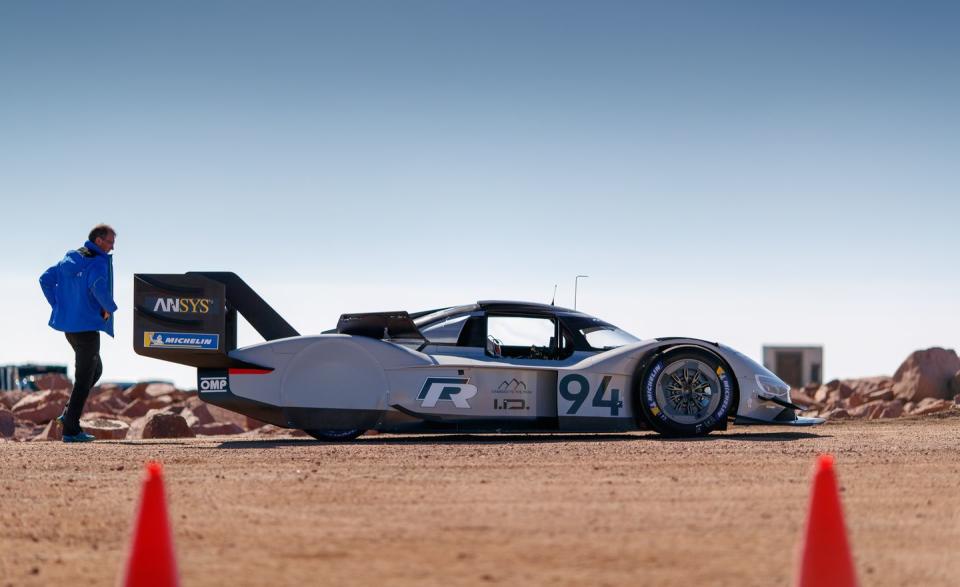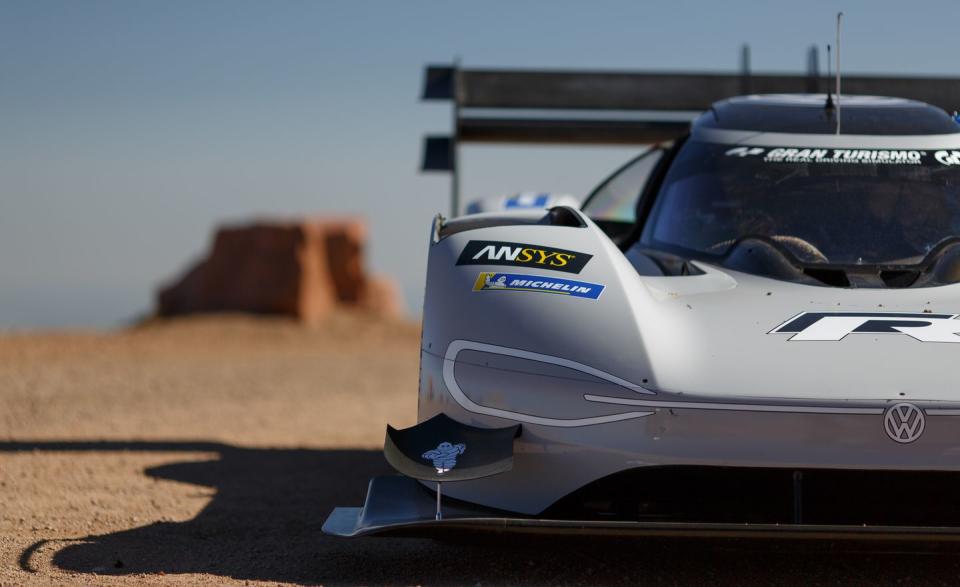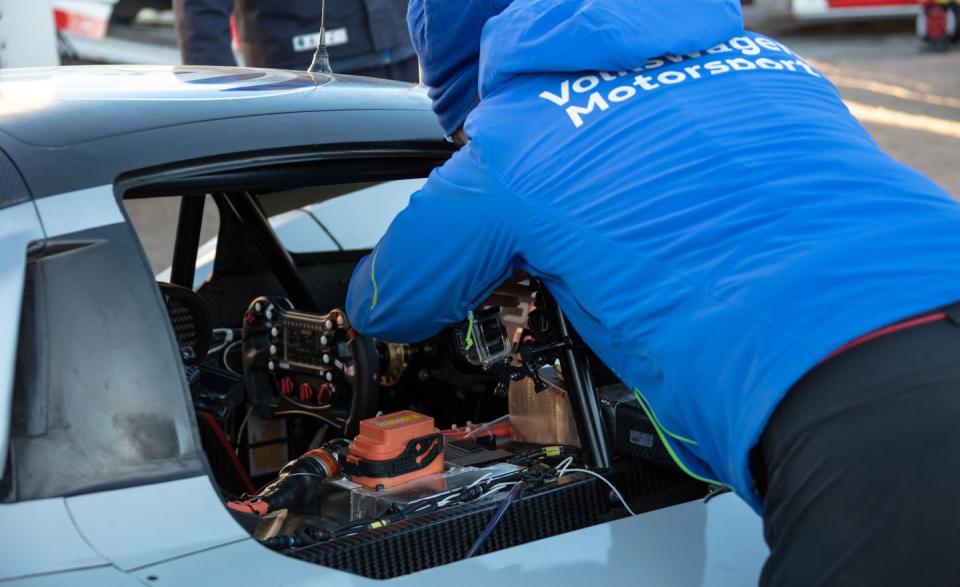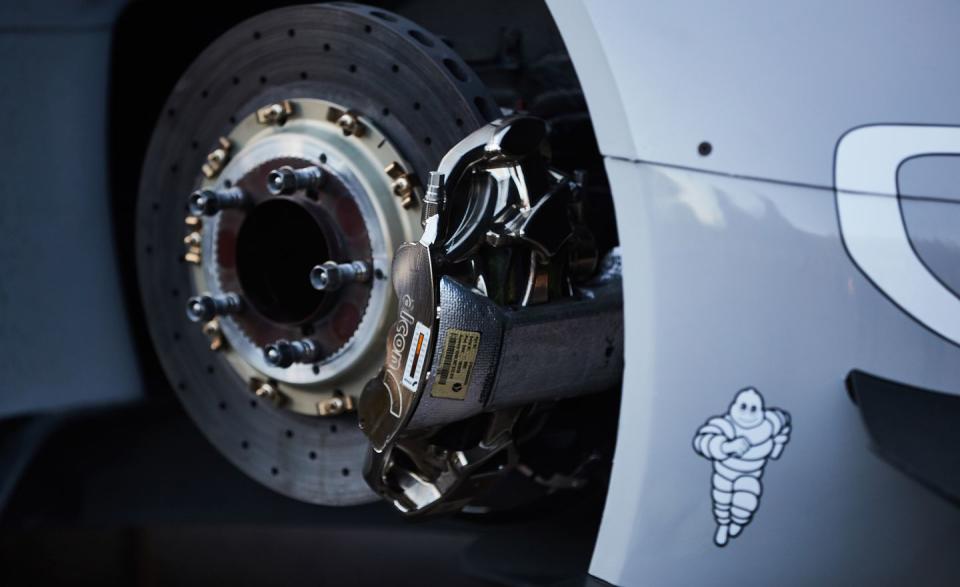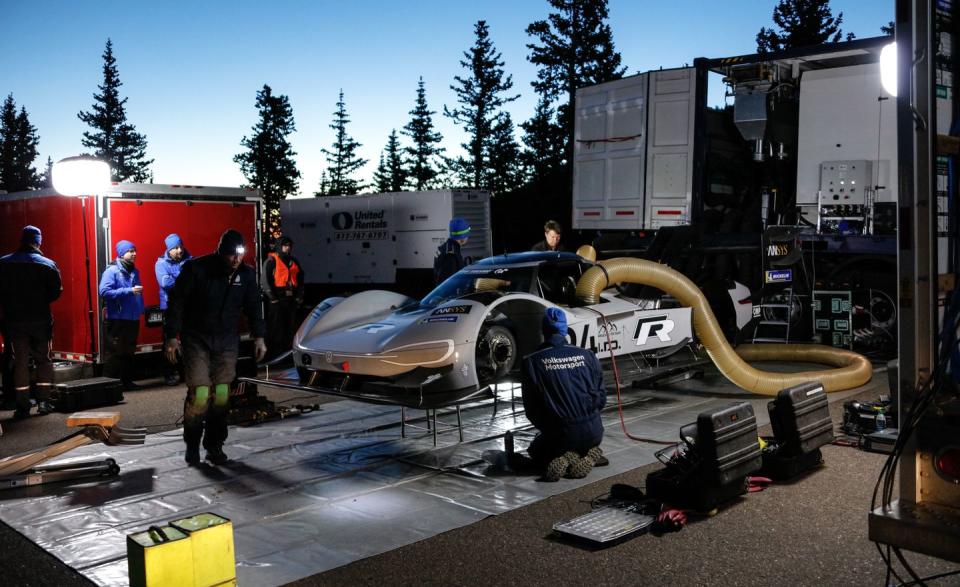Lightning in the Clouds: How VW’s Electric Racer Conquered Pikes Peak
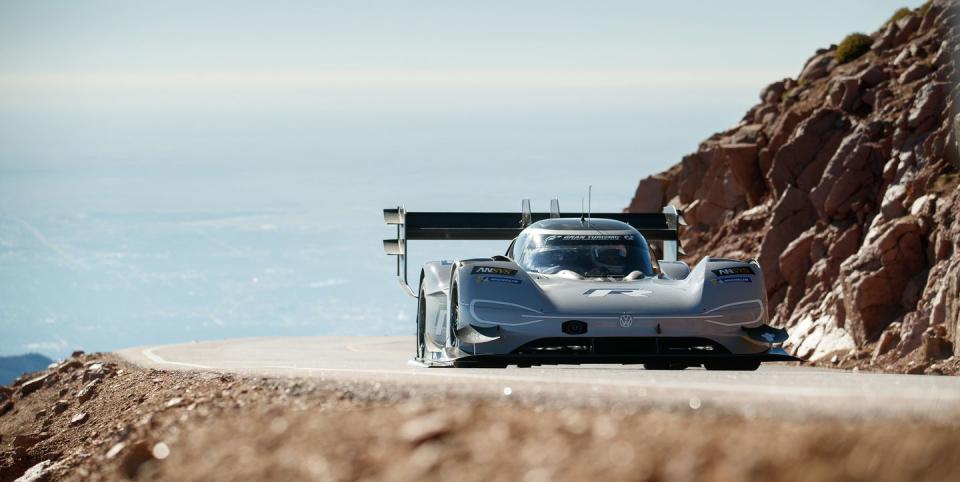
The Pikes Peak International Hill Climb is the second-oldest race in the country after the Indianapolis 500, dating to 1916. For most of its history, the competition was on a dirt road, but since 2012, the 12.42-mile course has been fully paved as it climbs 4725 feet to the top of the 14,114-foot mountain named for explorer and general Zebulon Pike. With 156 turns, limited sight distance, and varied camber and grade, the Pikes Peak course could be described as the American Nordschleife-with even less runoff and practice opportunity, and uphill all the way.
For the 2018 race, held on June 24-the 96th running-Volkswagen brought a sophisticated 21st-century machine called the I.D. R Pikes Peak. It shares the I.D. branding that VW has applied to its upcoming lineup of next-generation electrics. At least four such VW EVs have been announced, with the first to be introduced within two years, all claiming a driving range of at least 250 miles. This I.D. R Pikes Peak is intended to demonstrate that performance will also be part of this new electric brand.
Driven by Romain Dumas, who has won Pikes Peak three times before as well as claiming an equal number of victories at the Nürburgring 24 Hours and two wins at Le Mans, the I.D. R competed in the Unlimited category. Ostensibly, VW’s goal was to break the existing electric-car record of 8:57.118, set by Rhys Millen two years ago, but the unstated goal was the five-year-old outright record of 8:13.878, set by Sébastien Loeb in a Peugeot 208 T16 Pikes Peak special.
And that’s precisely what the VW did, completing the course in seven minutes, 57.148 seconds, slicing a full minute from the electric-car record and crushing the overall record by 16 seconds. All hail the new King of the Mountain and the first seven-minute ascent of the course. Here’s the technology behind VW’s purpose-built hill-climb rocket.
LMP Meets Formula E
At a glance, the I.D. R looks as if it came straight from the Le Mans 24-hour race run the preceding weekend. It has the same characteristic narrow, central, nominally two-place cockpit, surrounded by faired wheels and aerodynamically optimized bodywork. However, the I.D. R does look notably more graceful, thanks to its lack of headlights and much smaller air intakes.
The biggest difference is in the wings, which are enormous on the Pikes Peak car. They’re almost 18 inches wider than is allowed for an LMP car, and the I.D. R is longer by a similar amount, indications that the front splitter and the rear wing have deeper chords as well. This difference is motivated by both the looser rules at Pikes Peak and by the laws of physics.
For one thing, downforce is directly proportional to air density. At the 9390 feet of altitude at the starting line, air density is reduced by some 29 percent compared with sea level. At the summit, it drops another 12 percentage points. Larger wing area is one way to compensate for this reduction. Bigger wings mean more drag, of course, but the reduced air density also reduces that drag. Moreover, the top speed on the Pikes Peak course is only around 150 mph-some two-thirds of the speed on the Mulsanne straight at Le Mans-so the additional drag is not a major disadvantage.
This machine is energized by a pair of electric motors developing 250 kW, or 335 horsepower, each. These motors are said to be sourced from Formula E, where there is only one per car, with output limited to 200 kW, or 270 horsepower, this season. One motor, coupled directly to a differential, powers the rear wheels; the other bolts to a similar differential in front. Both motors are within the wheelbase to minimize the car’s polar moment of inertia.
When we asked why VW did not use a separate motor for each wheel-allowing fully flexible torque vectoring-we got slightly different answers. François-Xavier Demaison, the technical director of VW Motorsport, who is known as FX, said that four motors, even without differentials, would have weighed more than the two-motor setup. However, Willy Rampf, the technical advisor to the project-and former technical director of the Sauber F1 team-wasn’t so sure about the weight, but said he didn’t think the team had time to develop a torque-vectoring program given that the project was only begun in October 2017, a mere nine months before the race. There is some ability to vary the front/rear torque split to optimize handling and grip, Rampf said, but that split never departed very far from 50/50.
Peak Power
There’s only a single reduction ratio between the motors and the differentials, but it’s a big one, given that the motors spin at nearly 20,000 rpm. Such a high rotation speed is one secret to extracting big power from relatively small electric motors. For example, the MGU-K electric motor, which is geared to the crankshaft of a Formula 1 racing engine, spins at close to 50,000 rpm and develops 160 horsepower, yet it has a minimum weight of 15.4 pounds. We don’t know the exact weight of the motors in the VW racer, but Formula E cites 59 pounds for its version. That’s far less than a racing-grade internal-combustion engine of similar output.
The motors are energized by two battery packs-one placed adjacent to the driver and one behind the cockpit. The batteries are split into two solely for packaging reasons. Demaison said that the battery uses lithium-ion cells that are flat pouches, measuring roughly six by nine inches and 0.3 inch thick, sourced from A123. VW hasn’t said how many cells are in the battery packs, but Demaison did say that the total battery capacity was 43.0 kWh. If the car uses A123’s AMP20 M1HD-A cells, which fit his description, that capacity would be achieved using about 660 cells. Those cells can deliver the high power needed to energize the big motors and can also absorb big power generated during regenerative braking. Those 660 cells would weigh about 720 pounds, excluding the weight of their housings and cooling systems.
For a given wattage, using higher voltage and lower current means smaller-and lighter-wiring. Racing electrics usually operate somewhere below 1000 volts but above the 200 to 300 volts used in production electrics. Our guess is that the 660 cells are wired with 220 cells in series and three such packs in parallel, producing about 725 volts. We were told that the power control electronics are relatively conventional, using high-power controllers developed for the expanding electric-racing market, including Le Mans Prototype (LMP) and Formula E series.
Grip to Go-and Stop
This powertrain is packaged in a carbon-fiber chassis originally built as an LMP car by Norma, a French racing constructor. That means a proper racing suspension with geometry that uses one spring/shock unit for jounce control at each end and another spring/shock unit for roll control. One thing different about the I.D. R car is that it has a much more equal front/rear weight distribution than a typical LMP car for maximum traction at all four wheels. As a result, it runs the same size wheels at all four corners, wearing Michelin 31/71-18 racing slicks all around. These are essentially LMP racing tires with a very soft compound to cope with the expected cold temperatures-which can be around 70 degrees at the start line and potentially in the 40s at the summit-as well as pavement that is less than racetrack clean. And with an expected run well under 10 minutes, tire life was not critical. Tire pressure was not specified, though it started a lower little than usual, as the tires-even neglecting temperature effects-would gain about 2 psi during the 4725-foot climb during the run.
Despite the ability to brake hard using the twin electric motors in regenerative mode, the R racer employs normally sized racing carbon/carbon disc brakes. This is because at the bottom of the course, when the battery is nearly full, maximum regenerative braking is unavailable. A few miles into the run, however, the regen, combined with the friction brakes and huge downforce could produce deceleration as high as 5.0 g. While the friction brakes were full size, their cooling ducts were not, since the regen shared much of the braking load during most of the run. In fact, about 20 percent of the energy used by the motors during the run was recovered during regenerative braking.
That range of uncertain temperatures forced the engineers to rely on extensive computer simulation to design the car’s various cooling systems. According to the A123 spec sheet, the battery performs best around 70 degrees and should never be allowed to get hotter than 131-remarkably human in this regard. VW engineers chose to cool the battery with air ducted into the car, as this lightweight solution worked well with the pouch-type cells. Liquid cooling was used for the motors and power-control electronics, and those systems also required extensive computer simulations to design. For one thing, even at the start, ambient air pressure was only 10.4 psi, and that reduced air density reduces the heat transfer in a radiator. While temperatures tend to fall as the altitude increases, so does the air pressure. A lot of computer time was burned performing computational fluid-dynamics analysis to test for different scenarios. This was especially critical because there is little opportunity to practice on the Pikes Peak course, which is generally open to tourist traffic during the day and often covered with snow in the winter.
An Uphill Charge
Although the I.D. R’s battery had sufficient juice to complete its climb, the nature of the Pikes Peak competition made some sort of reasonably quick recharging necessary. That’s because, even after a car starts on its run, the course can be closed by a rock slide, a severe change of weather, or even a spectator who comes down with altitude sickness. That means that any car on the course would have to turn around, drive back down to the start, and be ready for another try at the mountain with only 20 minutes to get ready.
So VW developed a rapid charger with an output of 90 kW. That’s quick enough to recharge the battery in the allotted time, allowing for the fact that the regenerative braking on the downhill run back to the start would already help restore an only partly depleted battery. And this rate of charging did not threaten to overheat the battery, which could be cooled with external blowers as needed.
One twist is that this generator was powered by an internal-combustion engine fueled by glycerol. This is a nontoxic alcohol produced as a byproduct when manufacturing biodiesel fuel. It’s said to be safe enough to be used as an artificial sweetener in food. It’s also the oh-so-green fuel used to power generators in Formula E racing.
Buzzworthy: VW’s Pikes Peak Racer Shares Little with I.D. Namesakes
All Hail Zebulon! Bentley Offering Limited Pikes Peak Bentayga
Volkswagen e-Golf: Reviews, News, Specifications, Prices, and More
The I.D. R ended up weighing less than 2425 pounds with Dumas bolted into the driver’s seat. Each horsepower was only burdened with barely three and half pounds of mass, and VW quoted a zero-to-62-mph time of 2.25 seconds for the car, which seems conservative.
Electric motors lose no power as the air gets thinner higher up the mountain, unlike the starved-for-oxygen problem that has plagued internal-combustion Pikes Peak racers for more than a century.
This record-breaking run makes one wonder whether a car powered by an internal-combustion engine can ever again become King of the Mountain at Pikes Peak.
You Might Also Like

 Yahoo Autos
Yahoo Autos 
